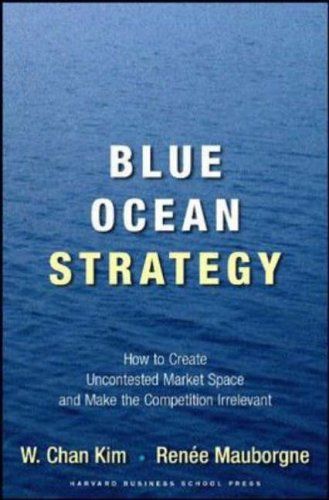W. Chan Kim and Renée Mauborgne’s updated, bestselling business classic guides you from stormy seas of constant competition to the calm waters of market dominance.

Sail Into Wide Open Waters
This best-selling business breakthrough by INSEAD strategy and international management professor W. Chan Kim and INSEAD distinguished fellow and World Economic Forum fellow Reneé Mauborgne provides an organized framework for identifying and implementing out-of-the-box “blue ocean strategies” for all industries.
Their 2005 work – which sold over four millions copies as a Wall Street Journal, Fast Company and Businessweek bestseller and is Amazon’s #1 Bestseller in Industrial Management & Leadership – remains relevant with this updated 2015 edition. Kim and Mauborgne’s insights have been translated into 46 languages, named Thinkers50 Strategy’s Best Business Book of the Decade and won the Carl S. Sloane Award for Excellence in Management Consulting; Fast Company chose it for its Leadership Hall of Fame.
Understating wildly, The Economist said this is, “… the most successful book on business master-planning.” The Financial Times called it, “one of the bestselling business books of the century.” The Wall Street Journal said that the authors show you not how “to beat the competition, but to make the competition irrelevant.”
Kim and Mauborgne’s research on the impact of innovative ideas on old industries still resonates. Their compelling business examples will inspire you as the authors provide implementable rules and principles, though at times they indulge in almost bulletproof academic jargon.
Kim and Mauborgne describe most businesses’ strategic approach as a collection of tactics that appear viable on their own, but fail to unite in a cohesive effort that differentiates a company. They show readers how to reach consumer emotions while promoting end-user benefits.
Market Boundaries
Kim and Mauborgne recommend examining your industry’s competitive drivers – customer preferences, product qualities, pricing and industry standards. What they deem “red ocean” strategies imagine finite markets.
Blue ocean strategy challenge companies to break out of the red ocean of blood competition by creating uncontested market space that makes the competition irrelevant.W. Chan Kim and Reneé Mauborgne
To expand your market boundaries into the wide blue ocean, they advise considering your main competitors’ limitations.
The Big Picture
The professors warn you to avoid getting lost in statistics. To maintain your sense of direction, Kim and Mauborgne suggest creating a strategy canvas – a graphic representation of your competitors’ products, prices and industry position. They believe this will help you consider your competitive environment through your customers’ eyes, so you can improve the factors that matter most to them. Kim and Mauborgne warn that if you want to exploit a trend, be sure it pertains to your business and has irreversible momentum.
Beyond Existing Demand
The authors believe a company’s natural focus on its current customers leads to better market segmentation analysis.
The strategic profile with high blue ocean potential has three complementary qualities: focus, divergence and a compelling tagline.W. Chan Kim and Renee Mauborgne
But one of their more revolutionary yet commonsense ideas is that real growth lies beyond existing demand and among potential future customers.
The Strategic Sequence
The authors maintain you must execute your strategy sequentially to achieve “value innovation.” Possessing a new technology, they warn, doesn’t mean you have a blue ocean product. Assess your product’s usefulness, ease, handiness, safety, entertainment value and environmental friendliness, Kim and Mauborgne advise on how each factor affects the customer buying your offering, bringing it home, using it, adding to it, keeping it working and, eventually, disposing of it.
Organizational Hurdles
Before you can achieve a blue ocean strategy, Kim and Mauborgne recommend resolving internal departmental differences. Managers may fret, they caution, about significant change; which problems will arise from reallocating resources; whether new practices will work and whether the transition will upset the existing social hierarchy.
Execution
A successful blue ocean launch requires extra effort from a cohesive crew. Kim and Mauborgne remind you to link the three “E Principles of Fair Process” – “engagement, explanation” and clear “expectation” – with the process of developing a strategy and acting on it at all levels of your organization. Building a blue ocean strategy involves uncertainty and risk; the professors warn that you must create and sustain trust among all participants.
Intelligence and Joy
Kim and Mauborgne convey downright joy when parsing business strategies. The authors offer a rare mix of insightful business analysis and astute, practical strategy. Most business authors are lucky if they can offer one or the other.Few combine both with such precision and utility.
Despite a few islands of dryness in their oceanic prose, Kim and Mauborgne understand human nature and how it manifests in business. They expect human foibles to undermine even the best strategies and tell you how to realize when your foibles are leading you do just that. Their prose is basic and straightforward with little rhythmic variation or literary flair. Dedicated readers of business texts will find their style articulate and easy to follow. Kim and Mauborgne use language to get ideas across, not to entertain or even engage.
The only way to beat the competition is to stop trying to beat the competition
W. Chan Kim, Renée Maulborgne
Those less versed in following strategic narratives may have to make an effort, but can absorb Kim and Mauborgne’s ideas in segments by taking breaks to digest their more complex content. While the authors salt their principles for intrepid strategists with their theory’s jargon, managers can navigate straight to the important strategic counsel. The potential positive effects of following Kim and Mauborgne’s advice make the investment of reading every single word worthwhile.
W. Chan Kim and Renée Mauborgne’s other books include Blue Ocean Shift; Red Ocean Traps; and Blue Ocean Leadership. Compelling bestselling business strategy books include Your Next Five Moves by Patrick Bet-David; Competitive Strategy by Michael E. Porter and The Innovators Dilemma by Clayton M. Christensen.







